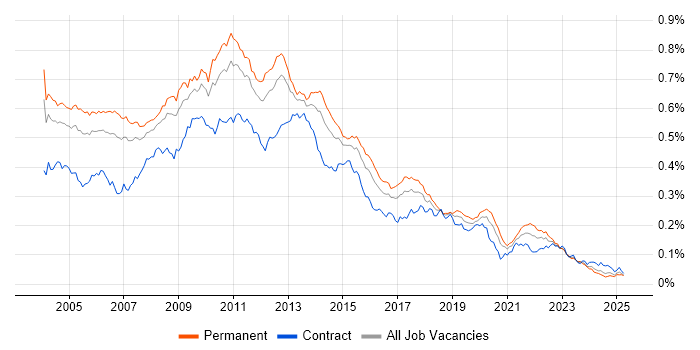Online Analytical Processing (OLAP)
UK
The table below provides summary statistics for permanent job vacancies requiring OLAP skills. It includes a benchmarking guide to the annual salaries offered in vacancies that cited OLAP over the 6 months leading up to 31 May 2025, comparing them to the same period in the previous two years.
| 6 months to 31 May 2025 |
Same period 2024 | Same period 2023 | |
|---|---|---|---|
| Rank | 685 | 856 | 877 |
| Rank change year-on-year | +171 | +21 | +61 |
| Permanent jobs citing OLAP | 17 | 51 | 91 |
| As % of all permanent jobs advertised in the UK | 0.030% | 0.049% | 0.095% |
| As % of the Database & Business Intelligence category | 0.22% | 0.28% | 0.44% |
| Number of salaries quoted | 11 | 35 | 76 |
| 10th Percentile | £41,750 | £48,036 | £45,000 |
| 25th Percentile | £58,125 | £56,250 | £49,688 |
| Median annual salary (50th Percentile) | £67,500 | £60,000 | £67,071 |
| Median % change year-on-year | +12.50% | -10.54% | +3.19% |
| 75th Percentile | £93,750 | £85,000 | £80,000 |
| 90th Percentile | £108,750 | £86,250 | £100,000 |
| UK excluding London median annual salary | £67,500 | £60,000 | £52,500 |
| % change year-on-year | +12.50% | +14.29% | -4.55% |
All Database and Business Intelligence Skills
UK
OLAP falls under the Databases and Business Intelligence category. For comparison with the information above, the following table provides summary statistics for all permanent job vacancies requiring database or business intelligence skills.
| Permanent vacancies with a requirement for database or business intelligence skills | 7,708 | 18,393 | 20,532 |
| As % of all permanent jobs advertised in the UK | 13.80% | 17.74% | 21.44% |
| Number of salaries quoted | 4,841 | 12,535 | 12,955 |
| 10th Percentile | £36,250 | £35,000 | £37,500 |
| 25th Percentile | £47,500 | £42,725 | £47,500 |
| Median annual salary (50th Percentile) | £60,500 | £57,500 | £65,000 |
| Median % change year-on-year | +5.22% | -11.54% | +8.33% |
| 75th Percentile | £82,751 | £77,500 | £82,500 |
| 90th Percentile | £112,500 | £97,500 | £103,750 |
| UK excluding London median annual salary | £55,000 | £52,500 | £55,000 |
| % change year-on-year | +4.76% | -4.55% | +4.76% |
OLAP
Job Vacancy Trend
Job postings citing OLAP as a proportion of all IT jobs advertised.

OLAP
Salary Trend
3-month moving average salary quoted in jobs citing OLAP.
OLAP
Salary Histogram
Salary distribution for jobs citing OLAP over the 6 months to 31 May 2025.
OLAP
Top 7 Job Locations
The table below looks at the demand and provides a guide to the median salaries quoted in IT jobs citing OLAP within the UK over the 6 months to 31 May 2025. The 'Rank Change' column provides an indication of the change in demand within each location based on the same 6 month period last year.
| Location | Rank Change on Same Period Last Year |
Matching Permanent IT Job Ads |
Median Salary Past 6 Months |
Median Salary % Change on Same Period Last Year |
Live Jobs |
|---|---|---|---|---|---|
| England | +142 | 15 | £92,500 | +54.17% | 24 |
| London | +107 | 10 | £92,500 | +77.88% | 19 |
| UK excluding London | +149 | 7 | £67,500 | +12.50% | 5 |
| North of England | +31 | 4 | - | - | 3 |
| Yorkshire | - | 4 | - | - | |
| Scotland | +117 | 2 | £67,500 | +29.64% | |
| South West | +109 | 1 | £43,500 | - | 1 |
OLAP
Co-occurring Skills and Capabilities by Category
The follow tables expand on the table above by listing co-occurrences grouped by category. The same employment type, locality and period is covered with up to 20 co-occurrences shown in each of the following categories:
